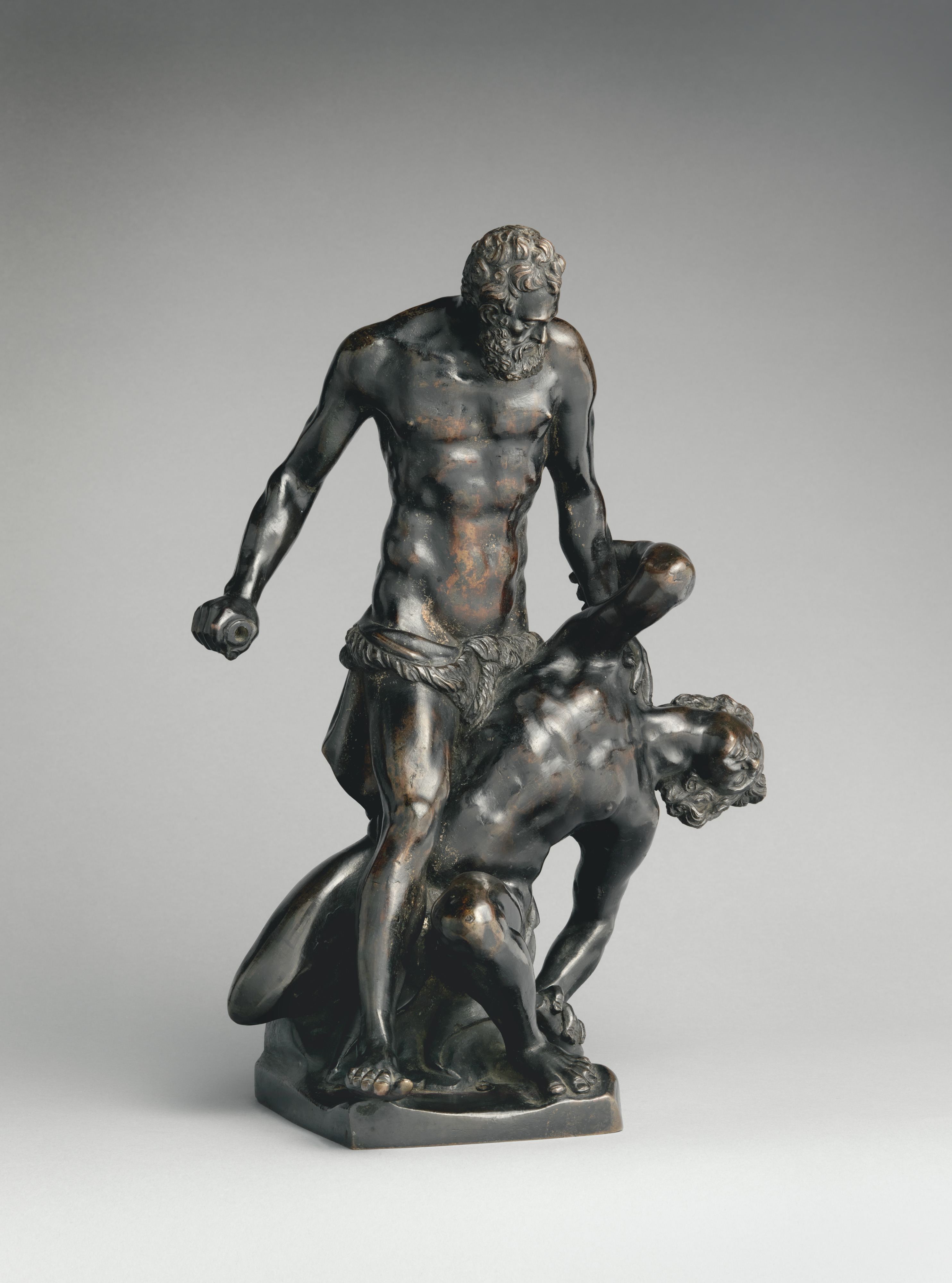Hercules and Cacus (?)
After Willem Danielsz van Tetrode Netherlandish
Not on view
Though this bronze depicting a man brandishing a weapon (now lost) astride a defeated youth has been variously identified as Hercules and Cacus or Samson Slaying a Philistine, the absence of recognizable attributes precludes a precise iconographic reading. As with cat. 99, one should more properly speak of a “victor and vanquished” pairing, a common compositional framework in early modern sculpture meant to convey a chain of actions and reactions between counterpoised figures. This conception was introduced during the first half of the sixteenth century by Florentine artists such as Michelangelo and Baccio Bandinelli in monumental creations like The Genius of Victory in the Palazzo Vecchio and the Hercules and Cacus in Piazza della Signoria, respectively.
The Blumenthal bronze entered The Met in 1941 described as a Hercules performing his tenth labor, which briefly served to sustain an attribution to Giambologna based on “thematic affinity.” His name was shortly replaced with a reference to an anonymous sixteenth-century artist from Central Italy. The object did not receive serious scholarly attention until 2004, when Dorothea Diemer embraced a hypothesis previously advanced by Hans Weihrauch for a similar cast in the Residenzmuseum, Munich, that he stated followed a prototype by Hubert Gerhard.[1] Weihrauch had included the Munich piece in a group of about forty bronzes held in the royal palace and made in the mid-seventeenth century that were likely cast from an earlier series now lost. Characterized by rough surfaces and awkward technique, the Munich bronzes were based on renowned models of ancient and modern statues. Diemer recognized the kinship between the New York and Munich statuettes, emphasizing the former’s superior casting and linking it to an unidentified invention ascribed to Gerhard.
A bronze of similar design and dimensions auctioned at Sotheby’s in 2014 can be added to this group. Once owned by Cyril Humphris, it was sold as a Samson Slaying the Philistine attributed to Willem van Tetrode, with no awareness of its correspondence to the New York and Munich sculptures.[2] In fact, this statuette, with its skillfully worked hair and veil covering the pudenda, might well be the earliest cast of the prototype known so far. If the absence of technical examination of the Munich bronze—described by Weihrauch as a “nachguss” (second cast)—does not permit a definitive conclusion, close study of our statuette indicates that it was likely a direct cast, imprecisely executed with deficient knowledge of the casting process. Evidence of a pre-formed core built up from an irregular lump of plaster and numerous scraps of wire, over which the wax was modeled and cast directly,[3] points to its function as a sketch of a composition that had wide appeal, perhaps due to a prestigious archetype. Frits Scholten believed the Sotheby’s bronze might derive from a primo pensiero produced in the late phase of Tetrode’s career, subsequent to his autograph models for Hercules and the Centaur (Robert H. Smith collection, Washington, D.C.) and Hercules and Antaeus (V&A), usually dated to the 1560s.[4] In chronological terms, this aligns with Diemer, who matched the Munich and New York works to Gerhard’s Hercules, Nessus, and Dejanira of around 1605 (Kunsthistorisches Museum). The sequence of the three casts remains speculative, however.
-TM
Footnotes
(For key to shortened references see bibliography in Allen, Italian Renaissance and Baroque Bronzes in The Metropolitan Museum of Art. NY: The Metropolitan Museum of Art, 2022.)
1. Residenzmuseum, ResMü.P.II.0014; see Weihrauch 1956, p. 231.
2. Sotheby’s, New York, January 30, 2014, lot 116.
3. The alloy is a leaded brass alloy with minor tin and the usual miscellaneous trace impurities. The use of brass as well as the pre-formed plaster core suggest the piece could be transalpine, possibly even French. R. Stone/TR, September 6, 2011.
4. Cited in the catalogue note for the Sotheby's sale.
Due to rights restrictions, this image cannot be enlarged, viewed at full screen, or downloaded.
This artwork is meant to be viewed from right to left. Scroll left to view more.




